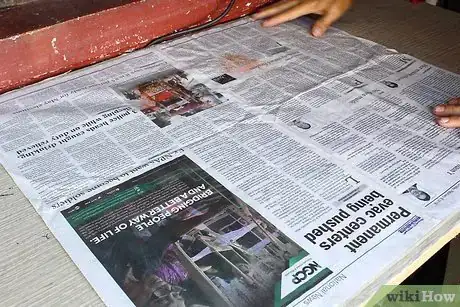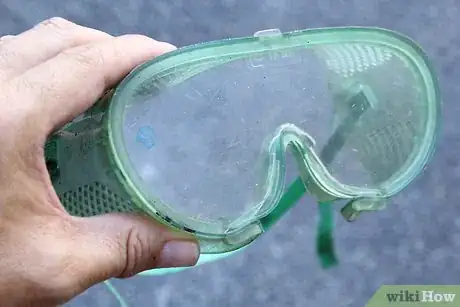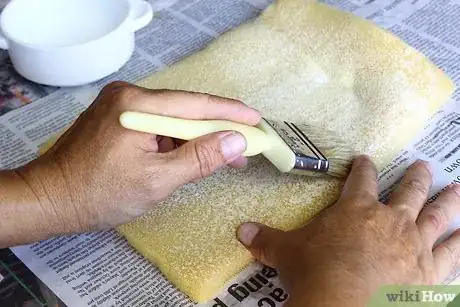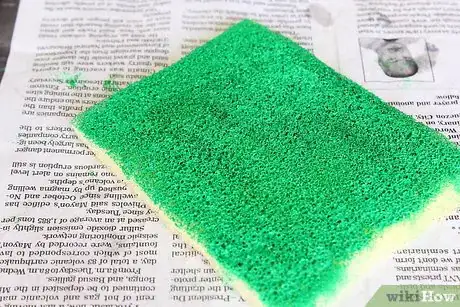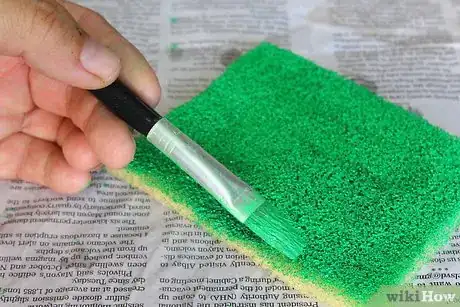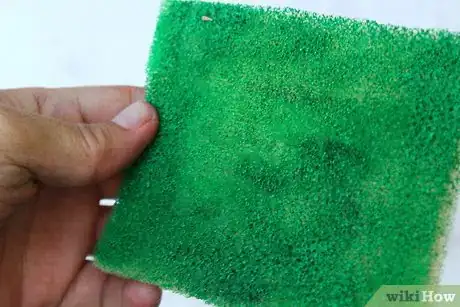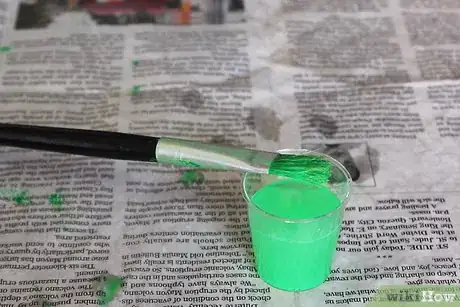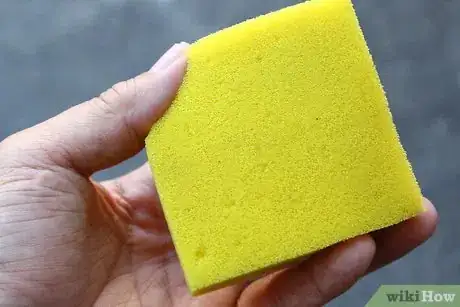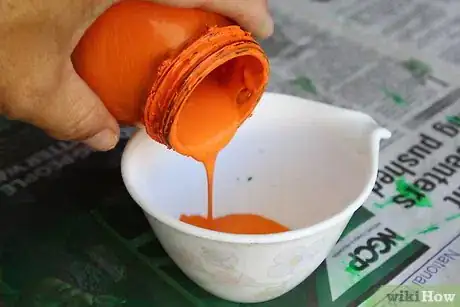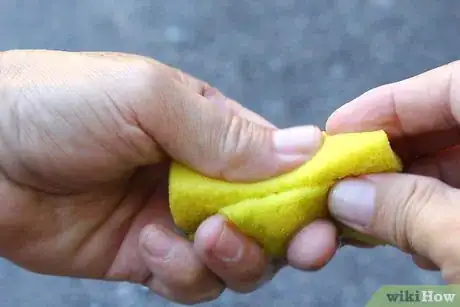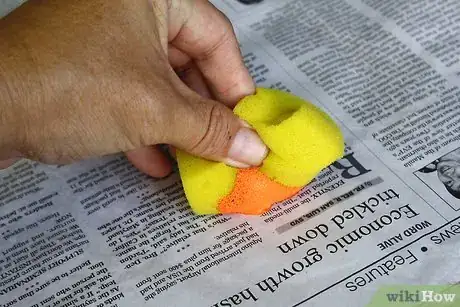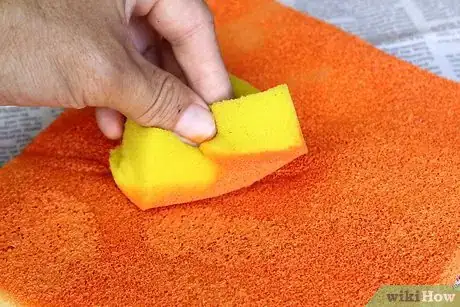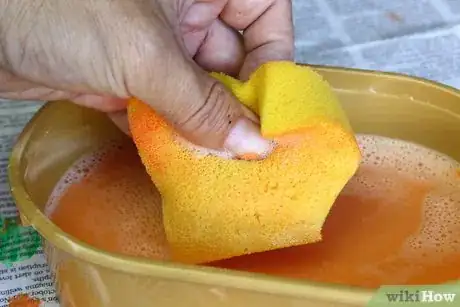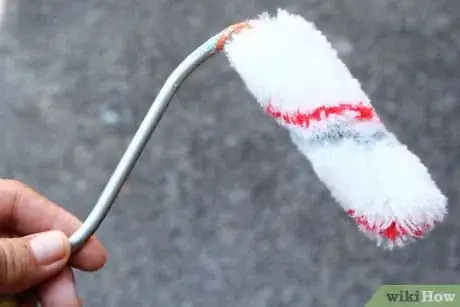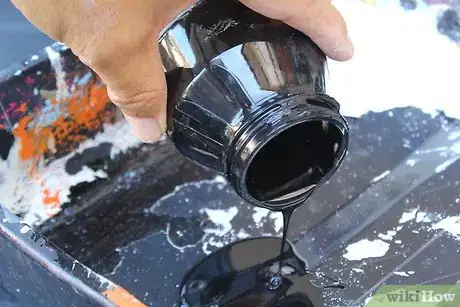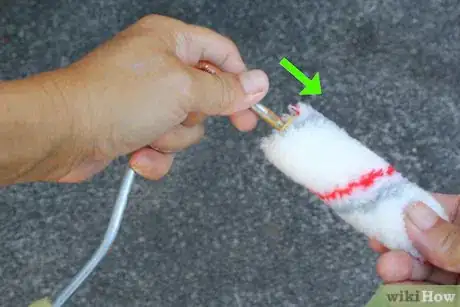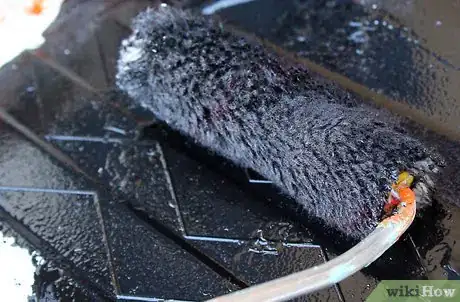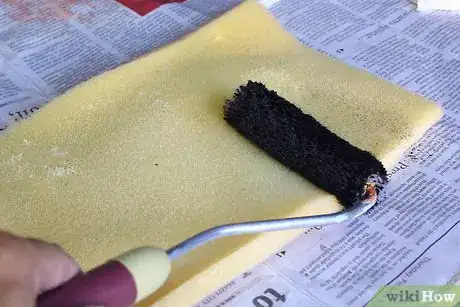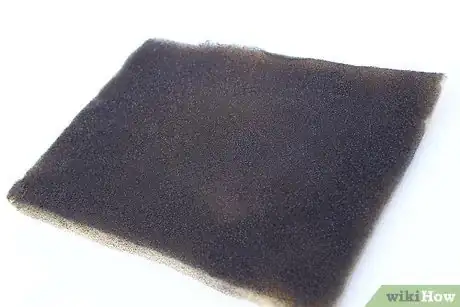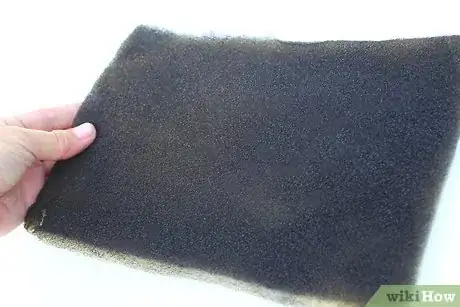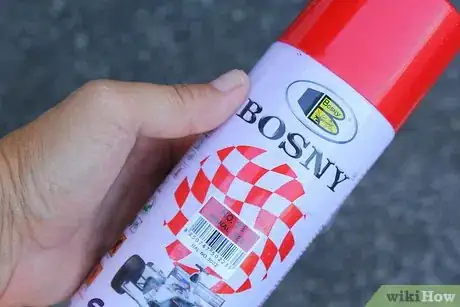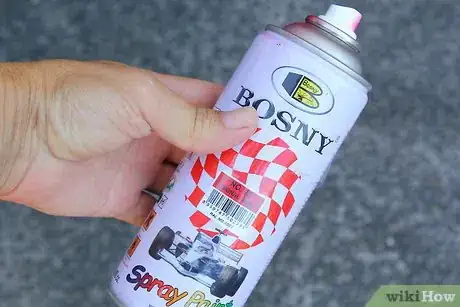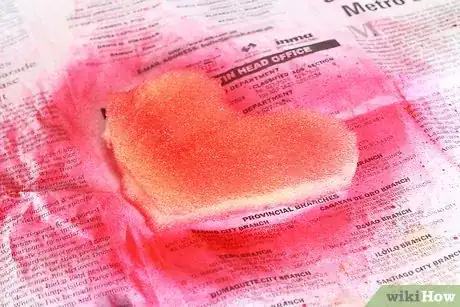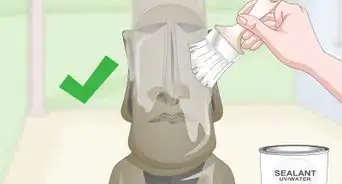This article was co-authored by wikiHow Staff. Our trained team of editors and researchers validate articles for accuracy and comprehensiveness. wikiHow's Content Management Team carefully monitors the work from our editorial staff to ensure that each article is backed by trusted research and meets our high quality standards.
There are 11 references cited in this article, which can be found at the bottom of the page.
This article has been viewed 63,649 times.
Learn more...
While it’s great for arts and crafts, foam is notoriously difficult to paint. Since its surface is covered in porous holes, you'll need to prime your foam with a mixture of wood glue and water before you paint it. You’ll also need to decide between using a paint brush, sponge, paint roller, or spray paint. Be sure to test a few pieces of foam before starting on your project.
Steps
Preparing Foam for Painting
-
1Find a well-ventilated space. You don’t want the chemicals from your paint to get into your lungs, so make sure the air in your painting area is circulating well.
- Try opening 2 windows across from each other to create a vacuum effect.[1]
-
2Cover your working area with newspaper. So you don’t make a mess, lay down a few layers of newspaper where you’re going to work.[2]
- If you don't have any newspaper, you can use plastic sheeting or painter's drop cloth instead. You could also work outdoors.
Advertisement -
3Put on safety glasses. When working with strong chemicals like wood glue and paint, make sure that your eyes are covered. Getting paint or glue in your eyes can cause severe damage.[3]
-
4Make a priming paste of 1:1 wood glue and water. In a bowl, combine 1 part water to 1 part wood glue with a disposable stirring stick (like a wooden chopstick or disposable cutlery) until it’s thick and not watery. The priming paste should have a jelly-like consistency.[4]
-
5Apply the paste with a paint brush, then let it dry until it turns clear. Use a paint brush to apply the paste to the foam, covering the surface of the foam. Use long, even strokes to completely cover the surface. All the strokes should be in the same direction to create an even base for the paint to adhere to. Then, allow the paste to dry until it turns clear.[5]
- The size of the paint brush will depend on the size of your foam project. If you have a very large project, use a 4.5 in (11 cm) brush, while if your project is small and intricate, you'll be better off with a 1.5 in (3.8 cm) brush.
- If the paste creates unsightly marks on the foam, wet your finger with water and brush them out before the paste dries.
- Depending on the temperature, drying could take up to 24 hours. Make sure that the paste has turned completely clear before you start painting.
Using a Paint Brush
-
1Get an artist paint brush for small decorations. If you’re doing small, intricate designs on your foam, use a paint brush. Small artist paint brushes are great if you need control when decorating your foam project.[6] These paint brushes are around 5–10 in (13–25 cm) long, and you can get them from an art store or general store for around $2 (£1.42). Many general stores also sell sets of them for around $5 (£3.55).
- For detailed work and thin lines, choose a “round” tip brush.
- For thick, heavy color and short strokes, use a “bright” tip brush.
- For filling wide spaces, try a “flat” brush.
- For filling corners, an “angular flat” brush is best.
-
2Put water-based acrylic paint in a flat palette. Choose the colors you’d like and squeeze them onto a flat palette. Keep them separate for now, but leave a small area in the middle of the palette for mixing colors.
- Water-based acrylic paint will dry faster than other methods, making it easier for you to apply multiple layers of paint on your foam.
-
3Use a dry brush to paint your foam project. Dip your dry paint brush into the paint and paint the foam. Don't be worried if the paint seeps into the foam, leaving white space; you'll follow up with another coat later.
- Dip your brush into a cup of water and swirl it around before switching colors. Dry it off with a paper towel before choosing a new color.
-
4Let the paint dry for at least 15 minutes. Let it dry for at least 15 minutes, though an hour will ensure that it gets perfectly dry.[7] If you don't let your foam dry before applying another coat, your paint brush may just move the old paint around instead of applying the new paint.
-
5Apply 2-3 coats of paint until the paint no longer sinks into the foam. Reapply paint in the same manner as before until you can't see white spots through the paint. Applying multiple coats will help the paint penetrate the porous surface of the foam.
-
6Allow your foam project to dry for at least an hour. Acrylics dry quickly, but you should still give your project at least an hour before handling it with bare hands.[8]
- Turning up the heat in your working area will help the drying process go faster.
-
7Dunk your brush in soapy water and wipe off the paint with your fingers. Fill a disposable cup with warm, soapy water and dunk your brush in when finished. Swirl the brush around and wipe the paint away with your fingers. Set your brush out to dry in a well-ventilated space.[9]
- Always wash your hands after handling acrylic paint.
Sponge-Painting
-
1Use natural sponges for an artsy, granite-like effect. Use a natural sea sponge (sponges harvested from the sea) for an interesting, multi-layered effect, similar to the look of granite (but with any color you choose). You can find natural sponges for around $10 (£7.10) at a hardware store.[10]
- Natural sea sponges often come in sizes of 5–6 in (13–15 cm).
- You can use a kitchen sponge, but it won't look quite the same.
-
2Put acrylic, water-based paints in separate disposable bowls. Choose the colors that you want to paint with and pour them into separate disposable bowls.[11]
- You can use foam bowls, paper bowls, or regular bowls that you've set aside for craft use (just remember they'll be dirty afterwards).
-
3Dampen a sponge with water and wring it out. Run water over the sponge enough to get it damp, then crush it with your hands until the water no longer runs out.[12]
- If you don't wring the sponge out, your paint may come out too watery and not adhere to the foam well.
-
4Dip the sponge into the paint, then blot some onto the newspaper. Choosing the paint you want to use, dip the sponge into it, blotting a little bit of paint off the sponge onto the newspaper so that you don’t make drips on your foam.[13]
- Try practicing your sponge painting on the newspaper before moving to the foam; this will give you a better idea of what you want to do on your project.
-
5Paint by applying the sponge softly to the foam’s surface. Touch the sponge to the foam gently, letting it rest on the foam for a few seconds before pulling it away. Repeat until the entire project is covered in paint.
- Try rotating the sponge while painting to get different effects.
- Dampen the sponge with clean water and wring it out before choosing another color.
-
6Wait at least 15 minutes for the paint to dry. It's important to let the paint dry before adding another coat, or it may end up looking uneven. You can wait up to 60 minutes to ensure the paint dries fully.
-
7Apply another coat of paint. Use the same technique to paint another coat. Focus on spots where the paint has seeped in and left white spots. Aim to create an even layer so that all the foam is covered.
-
8Let your project dry for an hour and wash your sponge. Give your foam project at least an hour to dry before picking it up. Wash your sponge in clean water and wring it out thoroughly, then let it dry in a ventilated area.
- Be sure to wash your hands with soap and warm water after handling paints.
Using a Paint Roller
-
1Paint with a paint roller for large, flat projects. If your foam project is large and flat, you'll be better off with a paint roller of around 9 in (23 cm), which can cover a high amount of space in a short time.
- A paint roller that's 9 in (23 cm) will cost around $7 (£4.95) at a hardware store. You'll also need a foam cover, which will cost around $5 (£3.55), and a paint tray, which will cost around $2 (£1.42).
-
2Pour latex paint into the tray and fill the small basin at the bottom. Pour the paint slowly into the tray and fill up the small basin, making sure you’ve left the screen (the ridged, tilted area inside the tray) free of paint.[14]
- You’ll be using this screen to scrape excess paint off of your roller, so make sure you haven’t filled it with paint.
- Latex paint will be the easiest to apply with a roller, and you can get 1 US gal (3.8 l) of it for about $20 (£14.12) at a hardware store.
-
3Slide the cover onto the paint roller and spin it. Slide the foam cover onto the paint roller and spin it several times to make sure that it will roll upon the surface you’re painting.
- If your roller doesn't spin, you may need to return it to the store. Alternatively, try using some WD-40 on the spinning barrel.
-
4Dip the roller into the paint, then scrape it against the screen. Dip your paint roller about 1⁄2 in (1.3 cm) into the paint, then roll it back and forth 2-3 times against the screen.[15]
- Scraping your roller against the screen will help even out the paint on the roller, which will reduce the likelihood of lumps on the foam.
-
5Paint the foam's outside edges first, then sweep up and down its length. Roll your paint around the edges of your project, ensuring that you've painted every corner. Once that’s done, roll the roller up and down the length of the project until the paint is smooth and covers the foam.[16]
- When your paint begins to thin out, reload the paint by dipping your roller into the tray and scraping it on the screen again.
-
6Wait 1-2 hours for the paint to dry. Latex paint should be allowed to dry for at least an hour. If you don't give the paint an hour, your roller will just roll the old paint around, instead of layering new paint on top.
-
7Apply a second coat of paint. Apply a second coat the same way you applied the first, being sure to scrape excess paint off of the roller.[17]
- If, after the second coat, you feel your project needs a third or fourth coat, apply them in the same way, waiting at least an hour between coats.
-
8Wait up to 30 days for the latex paint to cure. Latex paint needs days to cure (reach its full hardness). Leave the foam project in a warm room to dry for up to 30 days before handling it.
- If 30 days is too long, you can handle the project within 24 hours; just know that some paint might move around if you do so.
Spray-Painting
-
1Buy spray paint to cover your project with one color. If you need to cover your foam with one color of paint, a can of spray paint will suit your purposes well. It's cheap and, as long as a wood-glue finish is applied, it won't hurt your foam.
- Spray paint costs around $5 (£3.55).
-
2Shake the can for a full minute before getting started. Shake the can up and down then side to side to ensure that the paint mixes fully. Do this for at least a minute before you start to paint.
- If you forget to shake the can, the product may come out unmixed.[18]
-
3Spray the paint onto your project from at least 3 ft (0.91 m) away. Keep the nozzle of your spray paint at least 3 ft (0.91 m) away from your project when painting it. Any closer and the density of the paint could break through the primer and destroy the foam.[19]
- Paint in long, sweeping strokes to prevent drips and runs.
-
4Wait 5-10 minutes before applying another coat. Give the paint some time to dry before you spray another layer of paint onto your foam project. Continue to keep the can 3 ft (0.91 m) away from the foam.[20]
- Spraying too close when you apply the second coat will cause your paint to wrinkle.
-
5Let the paint dry for 24 hours. The spray paint should dry fully within a day. Touch the paint after 24 hours to see if it is dry. If the spray paint comes off onto your fingers, give it a few more hours to dry. Turning up the heat in your working area will also help to decrease drying time.[21]
Warnings
- Never let paint get into your eyes, mouth, or lungs. Avoid eating or drinking while painting, as paint can easily contaminate your food and drink.[22]⧼thumbs_response⧽
Things You'll Need
Using a Paint Brush
- Newspaper
- Wood glue and water
- Small, disposable bowl for wood glue primer
- Disposable cutlery or chopstick
- Artist paint brushes (5–10 in (13–25 cm) long)
- Flat artist's palette
- Acrylic, water-based paints
- Cup of soapy, warm water
Sponge-Painting
- Newspaper
- Wood glue and water
- Small, disposable bowl for wood glue primer
- Disposable cutlery or chopstick
- Natural sea sponge (5–6 in (13–15 cm) wide, available at most hardware stores)
- Disposable bowls for paints
Using a Roller
- Newspaper
- Wood glue and water
- Small, disposable bowl for wood glue primer
- Disposable cutlery or chopstick
- Paint roller (9 in (23 cm) long)
- Foam roller cover (9 in (23 cm) long)
- Paint rolling tray
- Latex paint
Spray-Painting
- Newspaper
- Wood glue and water
- Small, disposable bowl for wood glue primer
- Disposable cutlery or chopstick
- Can of spray paint
References
- ↑ https://www.apartmenttherapy.com/save-money-knowing-the-ins-and-148577
- ↑ https://www.youtube.com/watch?v=eBABqYL8GLg
- ↑ https://healthfully.com/remove-paint-eye-5569167.html
- ↑ http://kennycosplaystuff.com/sealing-foam/
- ↑ http://kennycosplaystuff.com/sealing-foam/
- ↑ https://www.art-is-fun.com/artist-paint-brushes/
- ↑ https://www.artistsnetwork.com/art-techniques/what-to-know-when-learning-how-to-paint-with-acrylics/
- ↑ https://www.artistsnetwork.com/art-techniques/what-to-know-when-learning-how-to-paint-with-acrylics/
- ↑ https://www.familyhandyman.com/tools/painting-tools/how-to-clean-paint-brushes/view-all/
- ↑ https://www.bhg.com/decorating/paint/decorative-painting/sponge-painting/
- ↑ https://www.bhg.com/decorating/paint/decorative-painting/sponge-painting/
- ↑ https://www.bhg.com/decorating/paint/decorative-painting/sponge-painting/
- ↑ https://www.bhg.com/decorating/paint/decorative-painting/sponge-painting/
- ↑ https://www.familyhandyman.com/painting/techniques/paint-roller-techniques-and-tips/view-all/
- ↑ https://www.familyhandyman.com/painting/techniques/paint-roller-techniques-and-tips/view-all/
- ↑ https://www.familyhandyman.com/painting/techniques/paint-roller-techniques-and-tips/view-all/
- ↑ https://www.familyhandyman.com/painting/techniques/paint-roller-techniques-and-tips/view-all/
- ↑ http://resources.schoolscience.co.uk/BAMA/11-14/aerosch5pg3.html
- ↑ https://www.youtube.com/watch?v=eBABqYL8GLg
- ↑ https://inmyownstyle.com/spray-paint-faqs
- ↑ https://inmyownstyle.com/spray-paint-faqs
- ↑ https://www.artistsnetwork.com/art-techniques/what-to-know-when-learning-how-to-paint-with-acrylics/
About This Article
To paint foam, you’ll need a primer and a water-based acrylic paint or spray paint. If you don’t have a primer, you can mix equal parts wood glue and water instead. Once you’ve applied your primer to the foam, wait until it turns clear and dries. Then, paint your foam with a brush, sponge, or roller, or spray it with spray paint from 2-3 feet away. Leave the first coat to dry for 15 minutes, then apply another 2 or 3 coats. You'll know it's well-covered when the paint doesn’t sink into your foam anymore. Leave your painted foam to dry for 1 hour if it’s acrylic or 24 hours if it’s spray paint. Make sure you work in a well-ventilated area with the windows open to protect you from the paint fumes. For more tips, including how to help you paint dry faster, read on!

